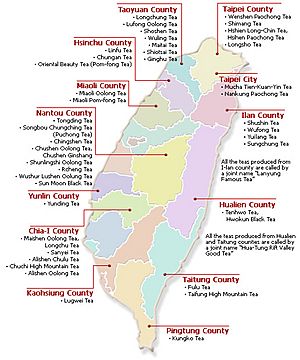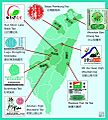Taiwanese tea facts for kids
Taiwanese tea comes in four main types: oolong tea, black tea, green tea, and white tea. People first found tea trees in Taiwan in 1717 in an area now known as Yuchi and Puli. Some teas from Taiwan still use the island's old name, Formosa.
Taiwan grows about 20% of the world's oolong tea.
Contents
History of Tea in Taiwan
Early Beginnings
Around the late 1700s, a person named Ke Chao brought tea trees from Fujian, China, to Taiwan. He planted them in an area that is now part of Ruifang District, New Taipei City. Records show that tea was being sold in the Muzha area even earlier, proving that tea has been a part of Taiwan for over 200 years.
In 1855, Lin Fengchi brought special Qingxin oolong tea plants from the Wuyi Mountains in Fujian to Taiwan. He planted them in Dongding Village, which is in Lugu, Nantou County. This is believed to be how Tung-ting tea started.
Tea Becomes an Export
After 1860, when the port of Tamsui opened for trade, a Scottish businessman named John Dodd helped make Taiwanese tea popular for export. He worked with tea sellers and farmers to send "Formosa Oolong" tea all over the world. Soon, tea became Taiwan's top export, even more important than sugar and camphor. The first teas sent overseas were oolong and baozhong tea, starting in 1865 and 1881.
In 1867, John Dodd opened a tea company in Taipei. He sold "Formosa Oolong" tea to other countries. He knew that the British were growing tea in India, so he wanted to create a different kind of tea in Taiwan. Pouchong oolong was known for its flowery taste. Other types of Taiwanese Oolongs include Dongding oolong, white tip oolong, and baochong oolong. In the late 1800s, oolong tea was almost the same as Taiwanese tea.
Japanese Influence and Modern Changes
When Japan took control of Taiwan, they wanted to make it like "another Darjeeling" for tea production. They started serious efforts in 1906, sending tea to Turkey and Russia. In the 1920s, they grew Indian tea types in Yuchi Township, Nantou County. In 1926, the Yuchi Black Tea Research Institute was started. This institute worked on mixing different tea types with Taiwan's native tea plants. The tea industry kept growing even through World War II.
After the war, the industry continued to grow until the 1960s, when it started to slow down. After the 1999 Jiji earthquake, the government spent a lot of money to help the tea industry recover.
During the 1950s and 1960s, China had trade embargos. This meant Taiwanese tea growers focused on the teas they already knew well. Later, when Chinese teas became more available, the Taiwanese tea industry started making special types of tea, especially Oolong. The government's Tea Inspection Office sorts teas into 18 different levels, from standard to very special.
The Tea Research and Extension Station, which started in 1903, helps promote Taiwanese tea. They do research and experiments to improve tea.
Where Tea Grows in Taiwan
Taiwan has several important areas where tea is grown:
- Northern Taiwan: This includes places like Hsindian, Pinglin, Muzha, and Yilan.
- Mid-central Area: You'll find tea here in Miaoli and Hsinchu.
- Eastern Taiwan: Areas like Taitung and Hualien grow tea.
- South-central Taiwan: This covers Nantou, Pingtung, Chiayi, Taichung, and Yunlin.
- High Mountain Regions: Famous tea mountains include Alishan, Yu Shan, and Hsueh Shan.
Types of Oolong Teas
Taiwan's weather and advanced tea-making methods help produce very good teas. Some of the most famous oolongs are "Formosa Dongding oolong," "Formosa Alishan oolong," and "Formosa oriental beauty." Many tea experts consider Taiwanese oolongs to be among the best. Some even call them the "Champagne of tea."
Oolong tea is picked five times a year in Taiwan, from April to December. The teas picked in July and August usually get the highest ratings.
Dongding Tea
This tea grows on Dongding mountain in Nantou County. It was brought to Taiwan in the 1800s from China. Its special qualities come from the almost constant fog in the area. Teas picked in spring often win awards and can sell for very high prices. Dongding oolong is not fermented as much as other oolongs. It is roasted over charcoal for about 40 minutes, which gives it flavors like "nutty, caramel, and chestnut."
Pouchong (or Baozhong) Tea
Pouchong oolong is a lightly oxidized tea. This means it's processed less than other oolongs. It has a twisted shape and floral smells, and it's usually not roasted. It's somewhere between green tea and what people usually think of as oolong tea. "Pouchong" refers to how it used to be wrapped in paper.
Oriental Beauty (Dongfang Meiren) Tea
This white tip oolong tea tastes very fruity. Queen Elizabeth II gave it the name "Oriental Beauty" in the 1960s. Its special flavor comes partly from tiny insects called leafhoppers. When these insects bite the tea leaves, the plant creates compounds that give the tea its unique taste. This has led to farmers allowing these insects and using organic growing practices for this tea.
Iron Goddess (Tie Guanyin) Tea
This tea first came from mainland China. There's a story that a tea grower found a special tea plant near an iron statue of Kuan Yin. Taiwan Muzha Iron Goddess tea is a traditional oolong. It is roasted, giving it a stronger taste and a roasted, nutty flavor. The tea liquid is reddish-brown. It is different from Anxi Iron Goddess tea, which is not roasted and has a greener taste.
High Mountain (Gao Shan) Teas
These teas are also called Alpine oolong. They are grown at high altitudes, usually 1,000 meters (about 3,300 feet) or higher.
Some high mountain teas are grown above 2,200 meters (about 7,200 feet). These were the most expensive Taiwanese teas in the 2000s, sometimes costing over $200 USD for 600 grams.
Teas grown above 2,500 meters (about 8,200 feet) are sometimes called the "king" of Taiwan high mountain tea. Because not much of this tea is made, it can cost around $200 to $500 USD for 500 grams. Because it's so popular, some dishonest sellers try to sell fake tea using its name.
This is a common name for lightly oxidized oolong tea. Much of it is picked in winter and called "winter tea." Among the oolongs from Ali Mountain, tea sellers often talk about the special qualities of the gold lily (Jin Xuan) tea. This is a type of tea plant developed in Taiwan in the 1980s. Oolong tea made from this plant has a unique milky flavor. However, in some areas, the most valued teas are made from the Qing Xin plant, which has a floral and fruity smell.
Osmanthus Oolong
This oolong tea is flavored with osmanthus flowers. Some flowers are also added to the tea after it's flavored. This tea is roasted and has floral and warming flavors.
Black Tea
Black Jade Taiwan Tea TTES #18 is a special type of tea plant developed by the Taiwan Tea Research and Experiment Station in the 1990s. This popular tea is a mix of two tea plants: Camellia sinensis v. assamica and a native Taiwanese type. It is said to taste like honey, cinnamon, and mint. The tea's natural sweetness comes from how tiny insects called leafhoppers interact with the plant. When leafhoppers bite the tea plant, the plant creates special compounds that give the tea its unique flavor.
Green Tea
Green teas like Dragon Well (Longjing tea) and Green Spiral (Biluochun) are grown in Sanxia District, New Taipei City.
Bubble Tea
Bubble tea started in Taiwan in the 1980s. Now, it is popular all over the world!
Images for kids




